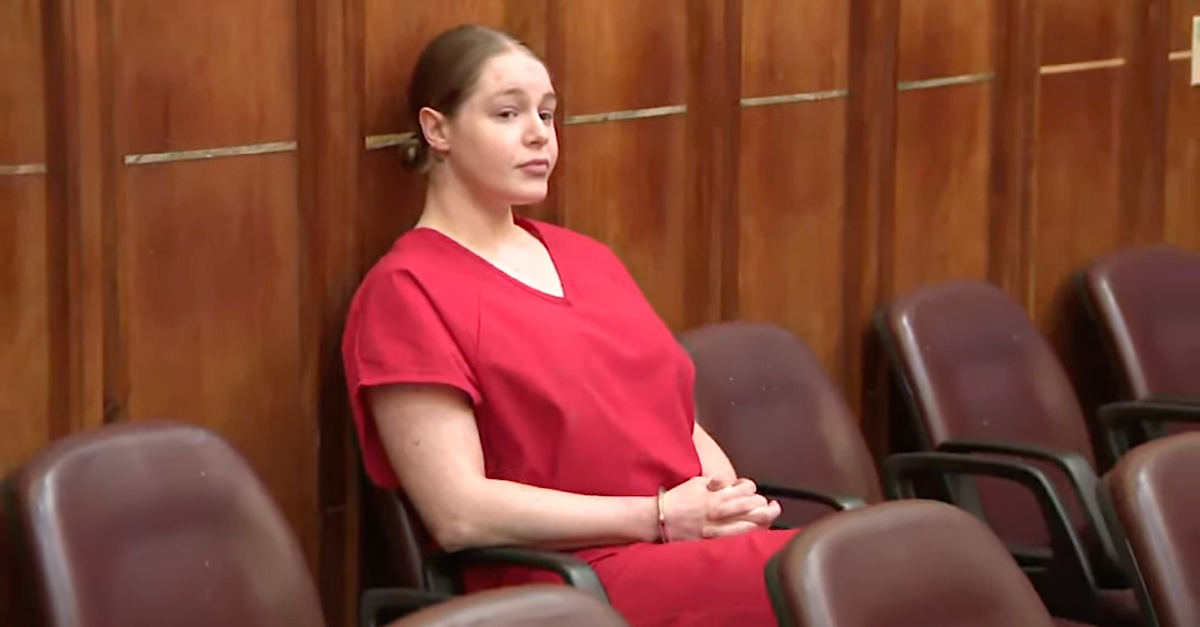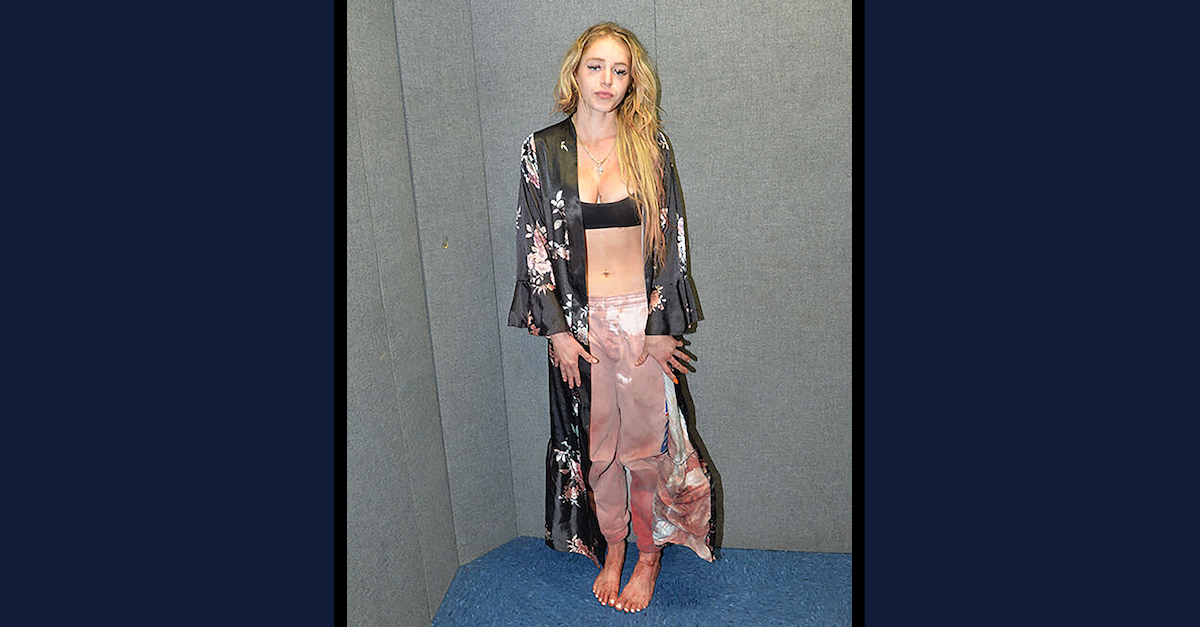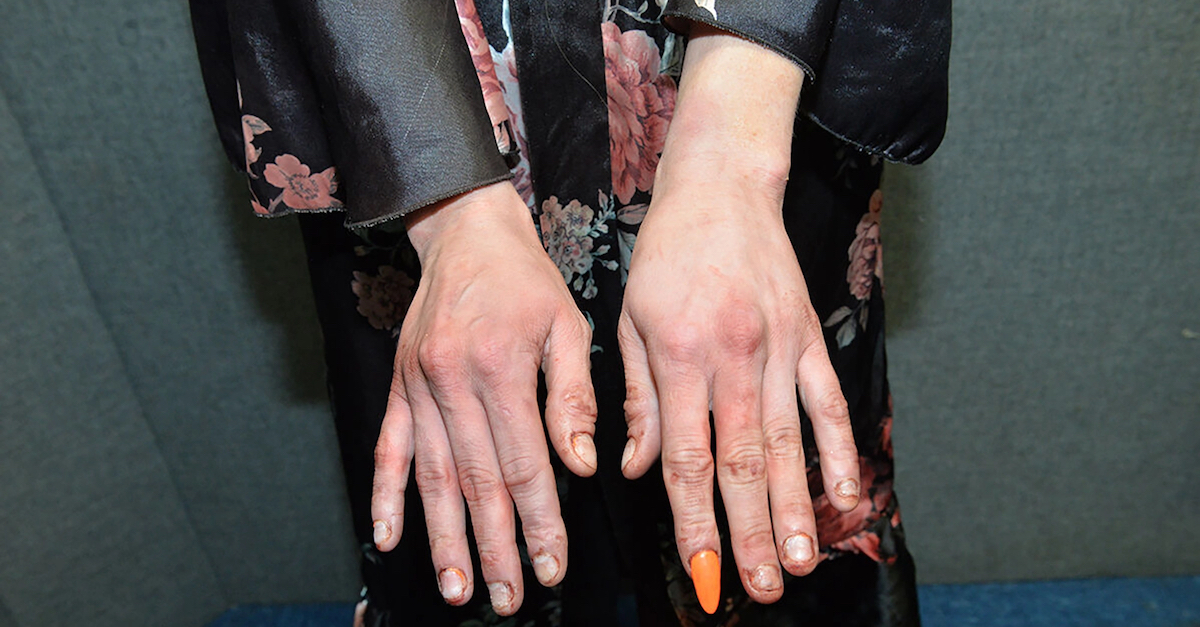
Courtney Clenney appeared in court on Nov. 15, 2022. (Image via the Law&Crime YouTube channel.)
Prosecutors on Tuesday sparred with defense attorneys during hours of testimony from the lead detective assigned to a murder case against OnlyFans and Instagram model Courtney Clenney. The question for the judge was whether Clenney should remain behind bars while awaiting trial or be granted some form of bail or bond — and whether or not several key recordings would be excluded from evidence.
Clenney, also known online as Courtney Tailor, is charged with second-degree murder over the stabbing death of her boyfriend Christian Tobechukwu “Toby” Obumseli, 27, a cryptocurrency trader with whom she shared a luxury Miami apartment.
Audio Recordings of Fights
Judge Laura Shearon Cruz ruled at the outset of the hearing that not all of the recordings of fights between the couple would be allowed into evidence. At issue was primarily the question of whether a privacy interest existed in recordings made within the ill-fated couple’s apartment. As part of that analysis, defense attorneys argued with prosecutors over whether or not the words uttered in some of the recordings were loud enough to be heard outside the apartment.
“A reasonable person shouting at the top of their lungs can expect that their neighbors will hear it and possibly record it,” one prosecutor said. “The fact that Christian recorded it is of no consequence. Whether she consented to it is of no consequence.”
Defense attorneys did not object to lobby video pertinent to the investigation; both sides agreed that those recordings occurred in public places. Neither side seemed to object to telephone calls made to a building security officer, either. The issue, rather, was of recordings made within the apartment itself without third parties present.
“There is no video . . . the recording device — the phone — is secreted on his person, so that’s where there is no video; it’s on his person,” a defense attorney said, however, of recordings Obumseli made of Clenney in their apartment.

Courtney Clenney. (Image via a Miami-Dade County Jail booking photo dated Aug. 26, 2022.)
The defense said the recordings at issue were “surreptitious” — an “illegal wiretap” — and that the apartment where the killing occurred occupied its own floor and contained its own elevator entrance. The defense noted that the setup of the luxury complex was not one of multiple units on a single floor separated by “thin” walls. Rather, they said Clenney had an expectation of privacy in anything recorded in secret in her own apartment — one the state could not penetrate.
“There were three months worth of Ms. Clenney screaming,” a prosecutor said. “An individual does not have an expectation of privacy in their sound waves being too far and too loud for other people to hear . . . it’s audible that she was screaming in the videos.”
The defense again reiterated that the apartment was, in essence, its own private floor — and therefore that Clenney reasonably expected that recordings of herself were private.
The judge said some of the recordings were so loud that she had to turn the volume down on her own computer — to its lowest possible setting — while reviewing them.
Judge Cruz ruled normal-volume conversations were private but that recordings of Clenney screaming “at the top of her lungs” were public because there was no “subjective expectation of privacy” in sounds that were so loud they could penetrate the walls of the unit — and evidence suggests that the sounds did, indeed, disturb several neighbors. Accordingly, several exhibits were admitted, but one was not.

Courtney Clenney appeared in court on Nov. 15, 2022. (Image via the Law&Crime YouTube channel.)
Motion for Pretrial Detention
The judge denied a defense motion to strike the state’s motion for pretrial detention for technical reasons. The judge also disagreed that the state failed to notify the defense of the witnesses it planned to call during Tuesday’s hearing.
A motion for pretrial detention was then examined on its merits.
Prosecutors played a video of Clenney dancing. They said it showed evidence of bruising on her legs prior to the fatal attack on Obumseli. Therefore, the bruises didn’t result from an attack on Clenney by her boyfriend that necessitated deadly force in her own defense, the state argued.
Clenney has long admitted stabbing Obumseli. She and her attorneys claim she fought back against Obumseli in self-defense; prosecutors say Obumseli was murdered.

Courtney Clenney appears in a police interrogation recording.
A homicide detective testified at the hearing that Obumseli was pronounced dead on Sun., April 3, at 5:55 p.m.
The detective said Clenney waived her Miranda rights and shared her version of what predicated the fatal stabbing of Obumseli.

An evidence photo shows the knife used to kill Christian Tobechukwu “Toby” Obumseli. (Image via the Miami-Dade State Attorney’s Office.)
According to the testimony, Clenney said Obumseli left the apartment and that an argument via text message ensued. The topic was about sharing their phones’ locations with one another. Obumseli returned; the argument became verbal at that point. Clenney claimed Obumseli “grabbed her by the neck” and “slammed her against the wall,” according to the detective’s words. Clenney claimed she was “able to break free” and tried to call her mother. Clenney next claimed Obumseli forced her to the ground but couldn’t explain how that happened, the detective testified. She allegedly said broke free yet again, went to the kitchen, grabbed a knife, and “flung” or “threw” the knife at Obumseli when he allegedly ran toward her. Clenney claimed the knife hit Obumseli in the shoulder, the detective said.
Later, the detective said Clenney described the throw of the knife in a motion similar to the throw of a football: she started by moving the knife behind her shoulder and heaved it at Obumseli. Clenney said Obumseli was about 10 feet away.
Obumseli was not armed when Clenney threw the knife, the interrogation revealed, according to the detective.
“It was not justified at all,” a prosecutor suggested at one point in the hearing. “The defendant’s statement is not credible. She could not have thrown the knife that would have landed at an angle, punctured three inches deep . . . that was physically impossible.”
The stab wound was three and a quarter inches deep, the state asserted, and punctured Obumseli’s subclavian artery.
Prosecutors described the wound as “downward and to the right” — a “cross-body” cut.

An evidence photo shows Courtney Clenney’s blood-stained pants. (Image via the Miami-Dade State Attorney’s Office.)
The authorities have long alleged that Clenney’s story about what happened doesn’t match the evidence.
Specifically, an Instagram video recorded before the fatal attack shows bruising on Clenney’s arms and legs, but not around her neck, the authorities said during the hearing.
The bruises were visible in the aforementioned Instagram videos and thus occurred before the killing occurred, the detective agreed. They were not the result of an attack that placed Clenney in imminent fear of life or limb, the state suggested.
Clenney’s defense attorneys suggested that their client was concerned for Obumseli’s condition and that Obumseli was bigger and stronger than Clenney.
The defense also suggested that photos of Clenney after the fatal stabbing did, indeed, show signs of “physical injury.”
The defense later grilled the detective over prior alleged acts of aggression by Obumseli toward Clenney. During or shortly before the fatal stabbing, Clenney, while on the phone with her mother, was heard saying “get back,” the detective testified, and Clenney was the one who called 911.

An evidence photo shows Courtney Clenney after the fatal stabbing. (Image via the Miami-Dade State Attorney’s Office.)
The defense further pointed to letters from Obumseli to Clenney in which the former admitted to “mentally abusing” the latter.
The state said Clenney’s own interrogation contains evidence that she was making up her story as she went along.
“Because I know — I was afraid,” Clenney said while describing the episode during a police interrogation recording replayed by prosecutors.
The state noted that Clenney paused when attempting to explain the killing as justified — proof, according to prosecutors, that she knew her version of events was less than plausible.
“She sat in her thought . . . she did not know whether this was justified at all,” a prosecutor argued.

An evidence photo shows Courtney Clenney’s hands after the fatal stabbing. (Image via the Miami-Dade State Attorney’s Office.)
Additionally, the state said Clenney called Obumseli several times in quick succession after broadcasting the video in question which depicted several of her bruises before the killing. Then, she started broadcasting again. The state suggested her behavior was not that of a person who feared Obumseli.
Prosecutors said Clenney made “was making attacks on Christian.”
Clenney called building security before calling 911, the state further noted.
The evening’s final question surrounded Clenney’s phone records — specifically, defense questions about precisely when the stabbing occurred. The prosecution asserted that Clenney called her mother, then building security, and then 911.
The bond hearing dragged on until nearly 5:50 p.m. despite commencing around 1:30 p.m.
No decision on the defendant’s bail status was rendered; she remains held without bond, according to the court docket. Additional testimony is planned for Thursday at 1:00. The medical examiner was contemplated several times as an additional witness; a financial expert was also suggested as a witness. The detective who did testify did not know the full status of Clenney’s finances, and the litigators seemed keep on ascertaining the depth of her bank account before any bond or bail amounts are set.
Have a tip we should know? [email protected]